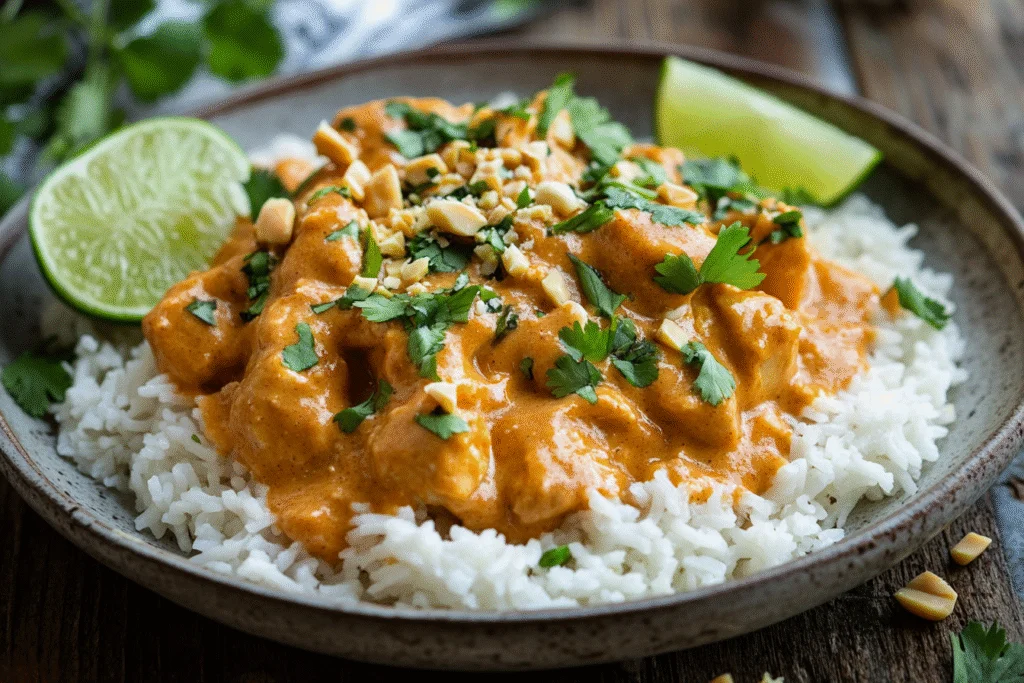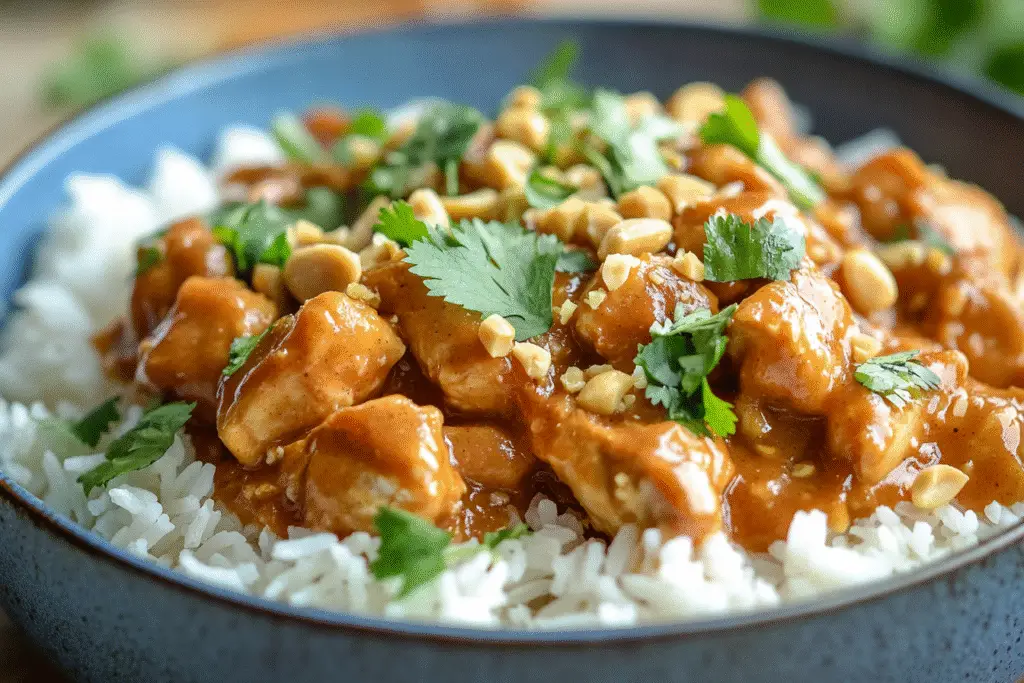Peanut Butter Chicken is a wonderfully unique dish that combines the richness of peanut butter with savory, slightly spicy flavors to create a creamy, comforting sauce that perfectly coats tender pieces of chicken. This dish is inspired by West African peanut stews and also finds its way into Asian-inspired peanut sauces, offering a delicious fusion of flavor profiles. It’s hearty, satisfying, and surprisingly simple to make with pantry staples.
Whether you serve it over fluffy white rice, steamed noodles, or alongside a fresh cucumber salad, peanut butter chicken is a crowd-pleaser that’s easy to customize to your spice preference. In this comprehensive guide, I’ll walk you through every step to make perfectly balanced peanut butter chicken—from selecting the best peanut butter, building a flavorful sauce, and cooking tender chicken to troubleshooting common issues like overly thick sauce or bland flavor.
Why Peanut Butter Chicken Works: Creamy, Nutty, and Boldly Satisfying
The secret to peanut butter chicken’s success is in its beautiful balance of sweet, savory, spicy, and creamy elements.
Core Flavor Elements:
- Peanut butter: Adds richness, nuttiness, and creaminess.
- Soy sauce and garlic: Provide savory umami.
- Ginger and chili flakes: Offer subtle heat and zing.
- Coconut milk (optional): Smooths and enriches the sauce.
- Lime or vinegar: Brings essential brightness to balance the richness.
The sauce is deeply flavorful and silky, coating the chicken perfectly for each satisfying bite.

Choosing the Right Peanut Butter: Creamy, Natural, or Processed?
Best Peanut Butter:
- Creamy, unsweetened peanut butter: Ideal for savory cooking. Smooth texture blends well into sauces.
- Natural peanut butter: Works if stirred thoroughly to incorporate oils.
- Avoid chunky or heavily sweetened peanut butter: These can disrupt sauce consistency and balance.
Pro Tip:
If using sweetened peanut butter, reduce added sugar in the sauce to avoid an overly sweet profile.
Selecting the Right Chicken: Tender and Quick-Cooking
Best Chicken Cuts:
- Boneless, skinless chicken thighs: Juicier and more forgiving, hold up well to simmering.
- Chicken breast: Works if cut into bite-sized pieces and cooked quickly to prevent dryness.
Preparation Tip:
- Cut chicken into even, bite-sized pieces for quick, uniform cooking.
- Marinate briefly in soy sauce or a peanut-based marinade for extra flavor if time allows.
Building the Peanut Sauce: The Perfect Balance
The sauce should be smooth, rich, slightly sweet, and gently spicy.

Essential Ingredients:
- Peanut butter
- Soy sauce
- Garlic
- Ginger
- Chicken broth or coconut milk
- Brown sugar or honey (for mild sweetness)
- Lime juice or rice vinegar (for acidity)
- Red pepper flakes or chili paste (for heat)
Key Tip:
Adjust the sauce consistency with chicken broth or coconut milk as needed—it should be pourable but still thick enough to coat chicken and rice.
Recommended Equipment
You’ll need:
- Large skillet or sauté pan: For browning chicken and simmering sauce.
- Mixing bowls: For prepping sauce ingredients.
- Wooden spoon or whisk: For smooth sauce mixing.
Optional: Rice cooker for prepping a fluffy rice base.
Common Mistakes and How to Avoid Them
1. Too Thick Sauce
- Happens if sauce isn’t thinned properly.
- Solution: Add more chicken broth or coconut milk a little at a time until the desired consistency is reached.
2. Overly Sweet Flavor
- Caused by using sweetened peanut butter without adjusting sugar.
- Solution: Use unsweetened peanut butter and taste before adding sweeteners.
3. Dry Chicken
- Can happen if chicken is overcooked.
- Solution: Use chicken thighs or cook chicken just until done.
4. Grainy Sauce
- Happens if sauce is added to a very hot pan or isn’t whisked well.
- Solution: Lower heat before adding sauce and whisk thoroughly for a smooth texture.
Preparation and Meal Planning Tips
Make-Ahead Friendly:
- Peanut sauce can be made up to 2 days in advance and refrigerated.
- Chicken can be marinated ahead of time for even more flavor.
Meal Prep:
- Peanut butter chicken stores well and makes excellent leftovers for lunches.
Serving Ideas:
- Best served with steamed rice, noodles, or sautéed vegetables.
- Pairs beautifully with a crisp cucumber salad or steamed broccoli to balance the richness.
Flavor Variations and Customizations
Protein Swaps:
- Substitute chicken with shrimp, tofu, or pork.
Spice Adjustments:
- Add more chili flakes, sriracha, or chili paste for heat.
- Omit chili for a mild, kid-friendly version.
Extra Veggies:
- Bell peppers, green beans, broccoli, or snap peas can be sautéed and added to the dish.
Sauce Twists:
- Use coconut milk for a more Southeast Asian-inspired version.
- Add a splash of fish sauce for extra umami depth.
Ingredient List
For the Chicken:
- 1.5 pounds (680 g) boneless, skinless chicken thighs or breasts, cut into bite-sized pieces
- 1 tablespoon soy sauce
- 1 tablespoon vegetable oil
For the Peanut Sauce:
- ½ cup (120 g) creamy peanut butter (unsweetened)
- ¼ cup (60 ml) low-sodium soy sauce
- 1 cup (240 ml) chicken broth or coconut milk
- 2 tablespoons brown sugar or honey
- 2 tablespoons rice vinegar or lime juice
- 2 cloves garlic, minced
- 1 tablespoon fresh ginger, minced
- ½ teaspoon red pepper flakes (adjust to taste)
- Optional: 1 tablespoon sriracha or chili paste for extra heat
For Serving:
- Steamed white or jasmine rice
- Fresh cilantro and lime wedges for garnish
- Optional: Crushed peanuts for texture
Step-By-Step Instructions
1. Cook the Chicken
In a large skillet, heat vegetable oil over medium-high heat.
Add chicken pieces and soy sauce. Sauté for 5–7 minutes until chicken is browned and cooked through.
Remove chicken from the skillet and set aside.
2. Build the Peanut Sauce
In the same skillet, lower heat to medium.
Add garlic and ginger and sauté for 30 seconds until fragrant.
Stir in peanut butter, soy sauce, chicken broth or coconut milk, brown sugar, rice vinegar, and red pepper flakes.
Whisk continuously until smooth and gently simmer for 2–3 minutes to thicken slightly.
3. Combine Chicken and Sauce
Return cooked chicken to the skillet and toss to coat in the peanut sauce.
Simmer for another 2–3 minutes to allow flavors to meld.
Adjust sauce thickness with additional broth if needed.
Taste and adjust seasoning with more soy sauce, lime juice, or chili if desired.
4. Serve
Spoon chicken and sauce over steamed rice.
Garnish with fresh cilantro, lime wedges, and optional crushed peanuts.
Serve hot with sautéed vegetables or a crisp side salad.
Troubleshooting and FAQs
Can I make peanut butter chicken without coconut milk?
Yes. Chicken broth works perfectly and keeps the sauce lighter.
What if my sauce is too salty?
Add a splash of water or unsalted broth and balance with a little more lime juice or sugar.
Can I freeze peanut butter chicken?
Yes. Cool completely and freeze in airtight containers for up to 2 months. Thaw overnight and reheat gently.
How do I make this vegetarian?
Substitute chicken with tofu or tempeh and use vegetable broth instead of chicken broth.
Variations: Classic, Spicy, and Vegetarian Versions
| Version | Protein | Sauce Base | Spice Level |
|---|---|---|---|
| Classic | Chicken thighs | Chicken broth | Mild to medium |
| Spicy | Chicken or shrimp | Chicken broth with sriracha | Medium to hot |
| Vegetarian | Tofu or tempeh | Vegetable broth or coconut milk | Mild to medium |
Storage and Reheating Tips
- Storage: Keep in an airtight container in the fridge for up to 4 days.
- Reheating: Warm gently on the stovetop or in the microwave, adding a splash of water if the sauce thickens too much.
- Freezing: Peanut butter chicken freezes well for up to 2 months.
Final Thoughts
Peanut Butter Chicken is a delightful, creamy, and flavor-packed dish that’s both comforting and exciting. The rich peanut sauce, tender chicken, and customizable spice level make it a versatile recipe you can easily adapt to your taste.
Whether you make it spicy, add extra vegetables, or swap in tofu or shrimp, this dish is simple enough for a weeknight but bold enough to feel special. I hope this step-by-step guide helps you create your perfect Peanut Butter Chicken—feel free to explore variations and make it your own!
